This year, I’ve averaged about $5,000 per month in earnings with online courses. Just so you know, I’m talking about 2020, in the middle of a pandemic. Here’s a picture to prove it to you.
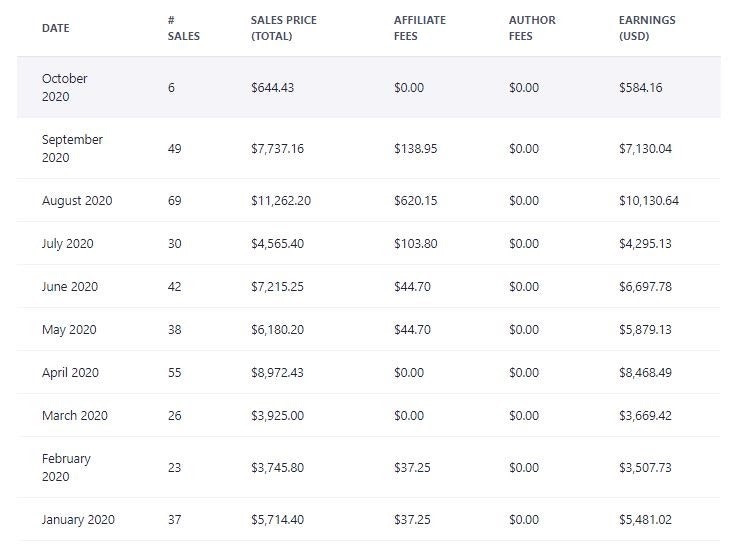
I’ve been selling online courses since 2017, actually. My first time I put on a live webinar, I sold ten spots of my first online course. It was as if I suddenly had the power to print money out of thin air – all that I had to do then was give students a product they liked.
For many reading this, they might not understand how to sell online courses online. What tools do you use? How do you accept payments? Where do you host the online course? How do you get people to come to a webinar so you can sell to them?
Well, I’ll be walking you through my whole process in this article.
My Four-Step Sales Funnel
As a general overview, here’s how my sales funnel works.
- Write an article on Medium.
- Reader signs up for my free email course via the call-to-action at the bottom of said article.
- Reader receives an email lesson every day for five days, then signs up for my webinar on the last lesson.
- Reader watches my webinar and buys my course at the end pitch.
Then all that’s left is for the reader to take my course, have a good experience, and be happy for spending their money with me.
Before I break down each step one by one, I want to talk about a few tools you’ll need to make this work.
Nine Necessary Tools for Online Courses
ConvertKit (free for 1,000 subscribers) – ConvertKit is an email marketing solution. This is where you’ll collect email addresses. You can make landing pages, email courses, and do everything you need to through here.
Teachable ($29 per month for base plan) – Teachable is the place you’ll host your online course lessons. It’s also the place you can accept payments. All you need to do is to hook up Stripe and PayPal to it, and you’re good to go.
WebinarJam ($499 per year) – WebinarJam is the best webinar solution on the market. Don’t wince at the price yet. You can try WebinarNinja for $39 per month and get up to 100 live attendees in the room.
Screencast-O-Matic ($1.65 per month) – This is a nifty tool for recording your screen. Good for recording video lessons for your course.
Google Slides (free) – I use Google Slides to create presentations, which I then record with my Screencast-O-Matic.
Microphone ($38) – This one should do just fine. I bought a USB microphone from Amazon four years ago and it still works today. You need a microphone for your webinar presentations and online course lessons.
Adobe Premiere Pro ($31 per month) – For editing course lessons.
Deadline Funnel ($49 per month) – For providing urgency in your sales funnel.
Now that we know all the tools needed for a good online course, let’s talk about the steps in depth.
Step One: Write an Article on Medium
For those who don’t know, Medium is a free blogging platform that already gets tens of millions of views per month.
It’s better to start here rather than, say, WordPress, because it takes five minutes to create a profile. If you were to set up your own site, it would take a long time to buy hosting, domain names, set up your theme, etc.
Start on Medium, there’s already a lot of great traffic waiting there for you.
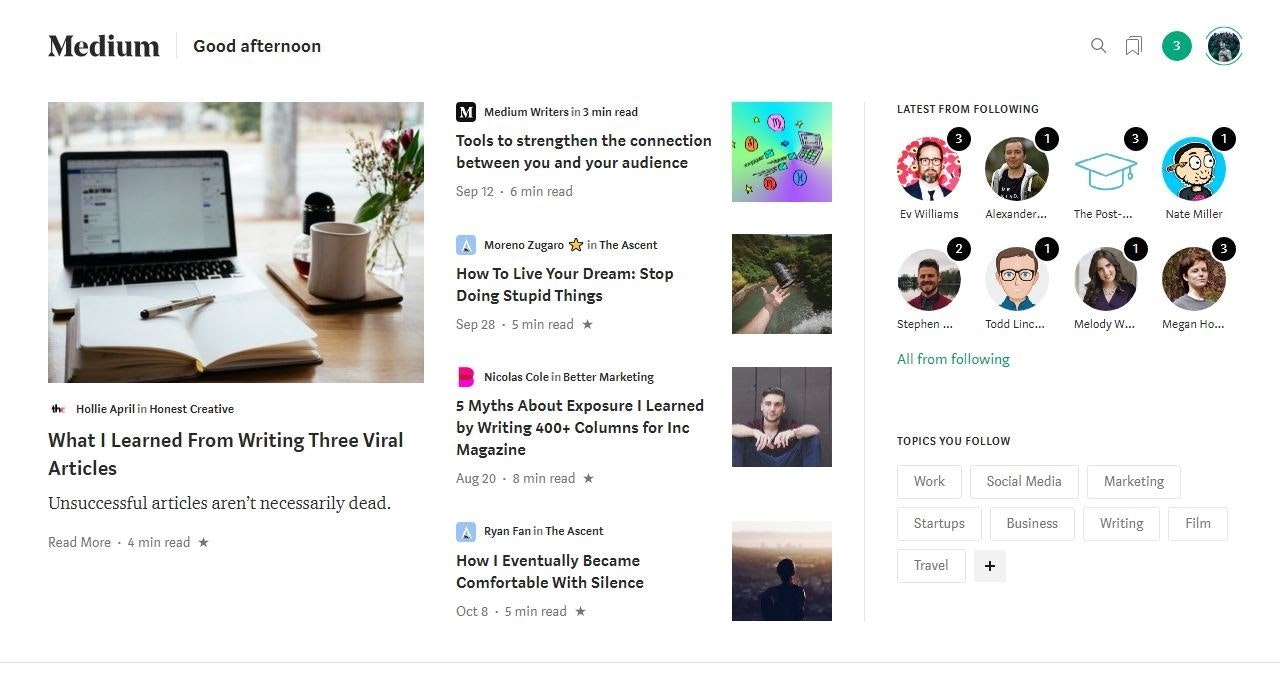
I’ve actually collaborated with Oberlo on a video discussing five steps to make your first $100 on Medium.
If you want a lot of basic Medium advice, start there! For now, I’ll urge you to try to get into big Medium publications. Some of the biggest and easiest to get into are:
- The Startup
- Curious
- PS I Love You
- Post-Grad Survival Guide
- Publishous
- Better Marketing
- The Ascent
- Entrepreneur’s Handbook
- Mind Cafe
When you get into a Medium publication, you leverage their audience to get in front of new eyeballs. So, if The Post-Grad Survival Guide has 38,000 followers, you will possibly get in front of a portion of those 38,000 readers.
When you’re accepted into a publication, which can only happen when you visit their homepage and follow the directions on the “Write For Us” link at the top, you’ll be able to submit to them.
When you’re ready to submit, open your draft in Medium, then just go to the top where you see the three dots and click on “Add to Publication.” From there, you can choose which publication you want to submit the article to, and then you hit “Submit”
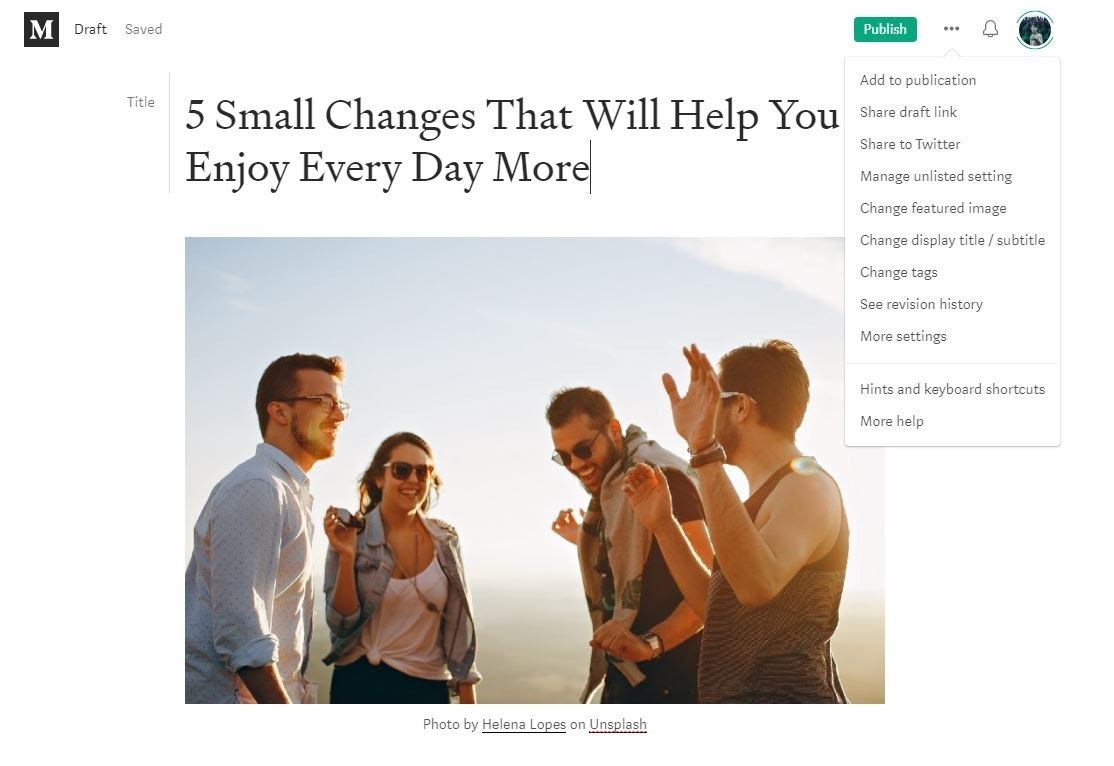
It’s that easy. Then, you wait for the publication owner to either publish your story, reject it, or give you feedback and ask for edits.
Step Two: Reader Signs up for Call-To-Action
At the bottom of your blog posts, typically there will be a call-to-action that looks like this:

It’s a link to a landing page where folks can sign up for your email list. Email lists are crucial in selling online courses. Without creating one inside ConvertKit, you’ll never capture any leads from places like Medium that you can then market your webinar to.
Think of it like catching fish in a river. Without a net or possibly your bare hands (#madskills), you’ll never catch anything for later.
An email list landing page is a place to “catch” leads that you can market your stuff to later.
Luckily, you can create landing pages in ConvertKit easily as well as free email courses.
I’ve linked two guides for you above that’ll teach you how to do both of those things.
All you need to know is that your call-to-action (or CTA for short) is extremely important. Without it, you’d find it hard to make a single dime selling online courses online.
Step Three: Prospective Student Signs up for My Webinar
On the backend of ConvertKit, I can create an automation that sends students one email per day for a specified time period.
It’s an awesome way to teach people things, not to mention it’s super easy to set up. You can just repurpose old blog posts to create a free email course.
“Why not just sell people your product during the email course, Tom?”
Great question.
I need to explain the selling efficiency of webinars really quick. Webinars convert, typically, at a ten to 15 percent rate. That means that if there are 100 people watching your webinar live, ten to 15 people will sign up for your offer on average. Neil Patel argues webinars can achieve a 19 percent conversion rate if you’re VERY good.
Emails have a lower conversion rate than webinars. Typically, it’s about one to two percent.
So, you can see that it makes more sense to put on a webinar to sell rather than an email course.
Taking people from an email course to your webinar is like transferring them from a horse and buggy to a Lamborghini. Now we’re talking.
I have two secret ways I get folks to sign up for my webinar through my email course.
For one, I leave links to my webinar at the bottom of every email lesson. Here’s what that it looks like:
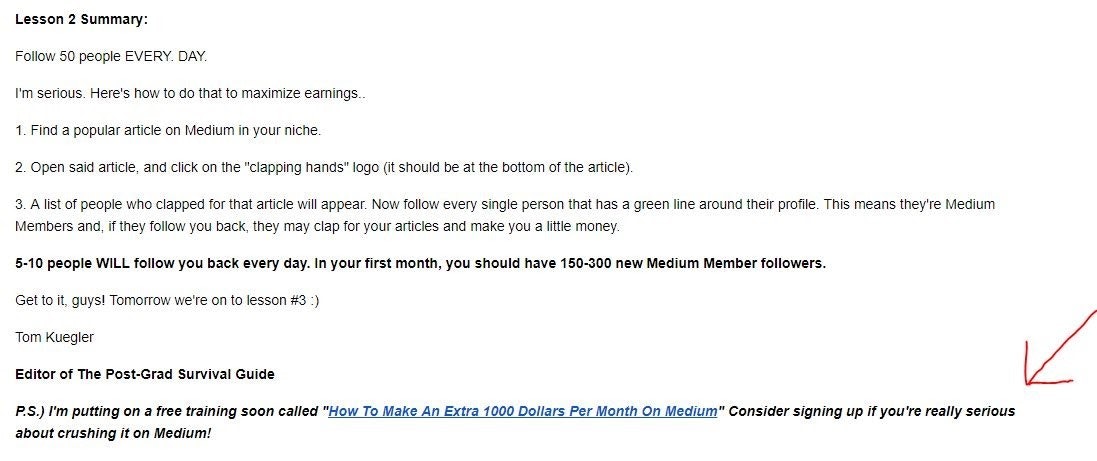
The second method is super buttery.
Basically, I’ll redirect people to my webinar registration page directly after they sign up for my email course. You can set this up in ConvertKit.
At landing page settings, you can select “redirect to an external page,” then paste in the URL you want them to go to. Theoretically, you could do this for anything. You could send folks to a blog post, a Facebook page – anything.
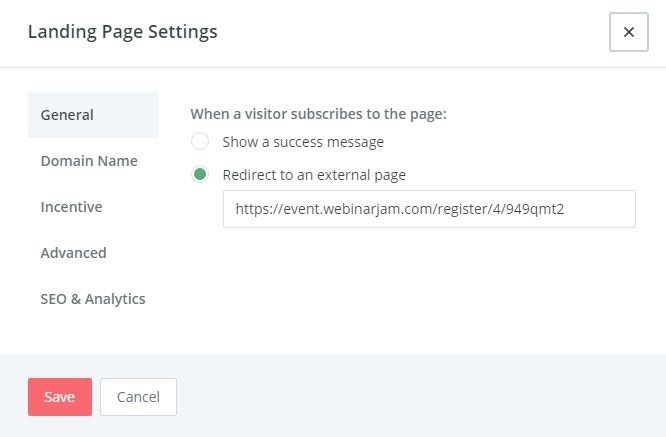
I believe that this trick is the single most useful one of them all.
I hear another question, “Tom, why don’t you just send people directly to your webinar page from Medium?”
Well, I could. It would work, too. You can do that if you like. For me, I like to warm people up to me first. One 40-minute webinar with some person they just read on Medium may not be enough for someone to purchase with me. After a five-day course, though, they’ll be more familiar with who I even am.
You can make that call for yourself.
Step Four: Convert Them on the Webinar
I could write an entire book about how to put on a successful webinar. Luckily, somebody already did. You should read this book by Russell Brunson (founder of ClickFunnels). He explains everything about a successful webinar in there.
Use Google Slides to create your own presentation. Webinars are basically just a slide show. Mine is about 100 slides.
Normally, you have an introduction, the presentation itself, then the pitch at the end.
The introduction should only be about five to seven minutes TOPS. The presentation should be about 20 to 25 minutes. Then the pitch should be ten.
Want to know the most important webinar tip I’ve ever learned?
Webinars should definitely teach people things, but your main goal is to break down barriers to purchase. What would be some objections from somebody buying your course?
For example, I have a writing course that I sell. One objection I commonly get is, “I don’t have time to write.” In the webinar, I show them how, if they wrote shorter posts, they would have time to write EVERY SINGLE DAY.
Objection surmounted. Before you create a webinar, you need to think about your product and what three big objections people might have for not buying your course. Then you spend your webinar breaking down those objections while teaching folks something worthwhile.
This leads us to our last point. How do you actually convert people?
Well, at the end, you link out to your course sales page that’s hosted on Teachable. You can actually create a time-sensitive coupon that expires in 20 minutes using a tool like Deadline Funnel. That tool works wonders and has resulted in tens of thousands in sales for me.
Russell Brunson’s book really spells out how to pitch your product at the end of the webinar using something called “The Stack,” so make sure you check that out.
The Math: How To Actually Make $5,000 Every Month
Let’s do the math for a second. How many blog post views do you need to make $5,000 in one month? It all depends on subscribers. Typically, CTAs at the end of blog posts convert at about a one to two percent rate.
To get 1,000 new subscribers in one month, you need 50,000 to 100,000 blog post views.
After that, 60 to 80 percent of subscribers will end up signing up for your webinar.
Which means you’ll have 600 to 800 webinar sign-ups.
Not so fast. Only about 40 percent of registrants arrive for the live webinar, so you’ll get 240 to 320 in there live if you’re lucky.
Which means 36 to 48 people will sign up for your course. If you have a $200-course, that’s $7,200 to $9,600 in earnings.
There are a lot of ifs, buts, and maybes in that analysis, but you can be confident that if you got 50,000 views in one month, then you could get somewhere close to $5,000 in revenue if you use my method outlined in this blog post.
Don’t forget to use all the guides and resources I mentioned, too.

Don’t wait for someone else to do it. Hire yourself and start calling the shots.
Get Started Free



